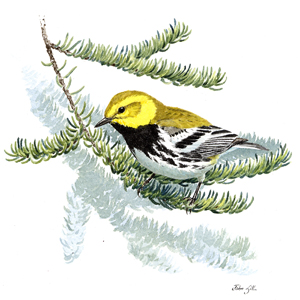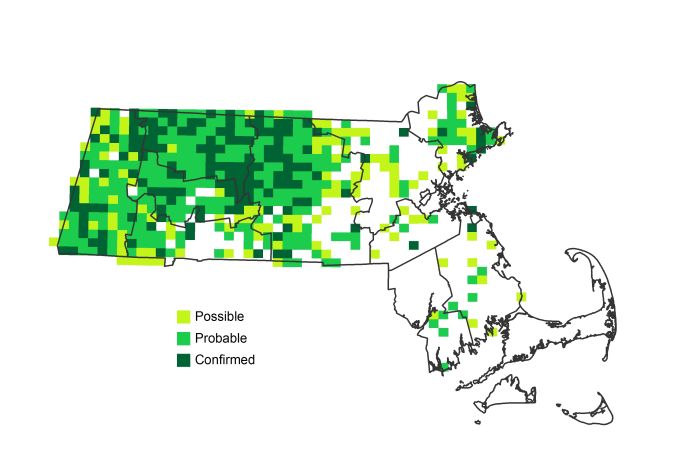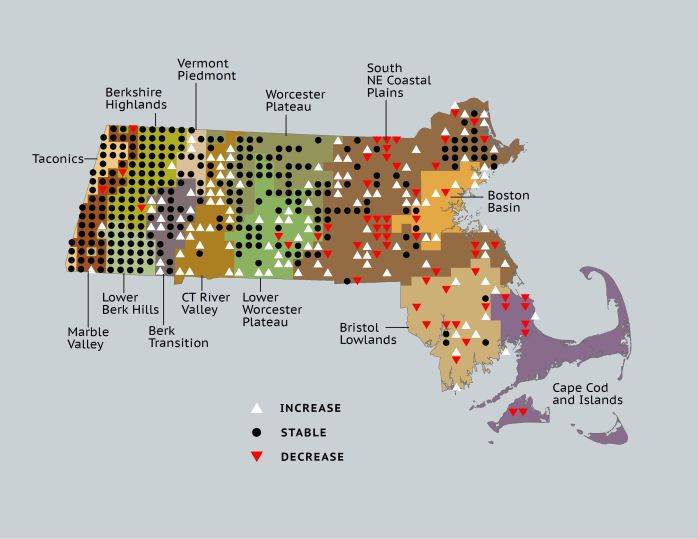Find a Bird
Black-throated Green Warbler
Dendroica virens

Widespread and likely increasing
“The very name of the black-throated green warbler carries me back to boyhood days and to a certain pine-crested hill in Massachusetts, from which was wafted on an early spring morning the song of this bird.” – Henry M. Henshaw, The Book of Birds: Common Birds of Town and Country and American Game Birds
The Black-throated Green Warbler seems determined to convince us that there are tongues in trees. The species’ distinctive song often likened to the phrase, trees, trees, murmuring trees! is among the easiest to learn of any wood warbler, and it delivers it almost constantly during both the early breeding season. Black-throated Green Warblers are most commonly found in the heart of a forest, particularly if the woods are dominated by coniferous growth. The reforestation of the state has so far been kind to the Black-throated Green Warbler, but concerns may lie ahead because of the arrival of a hemlock tree pest.
Historic Status
Mid-nineteenth-century observers counted any breeding Black-throated Green Warbler in Massachusetts as an oddity. By the late 1870s, however, that tune had changed, and words such as “common” and “abundant” frequently found their way into reports describing the summer status of the species, everywhere from the top of Mount Greylock in the Berkshires to Cambridge and Cohasset in eastern Massachusetts. “They are summer-residents throughout New England, but are particularly common in certain parts of Eastern Massachusetts,” wrote Henry Davis Minot (Minot 1877). As reforestation continued into the twentieth century, the distribution of the species across the state changed radically.
Atlas 1 Distribution
During Atlas 1, the forests of the western hill country were filled with the lazy, lisping songs of breeding Black-throated Green Warblers, and they were recorded in 38% of the blocks statewide. This warbler’s affinity for the high-elevation conifer-dominated forests of western Massachusetts becomes clear when one examines block occupancy in the western parts of the state; fully 47% of their statewide range was from the Connecticut River Valley westward. They did not shy away from the central Worcester Plateau regions and Coastal Plains, which accounted for nearly the balance of their occupied blocks, at 46% of their statewide range. The Bristol/Narragansett Lowlands had a notable presence for this warbler too, and while most of the Pitch Pine forests of Cape Cod and the Islands were unsuitable for Black-throated Green Warblers to breed, the birds nonetheless put in a few appearances on Martha’s Vineyard.
Atlas 2 Distribution and Change
In Atlas 2 Black-throated Green Warblers were still doing well in western Massachusetts, and they upped their statewide footprint to 51%. Persistence was the watchword and the species saw very few losses, and even a consolidation of the range where it was able in the west. Overall occupancy in the Connecticut River Valley more than quadrupled from 8 blocks to 38, and both Worcester Plateau regions showed impressive growth. Atlasers on the Coastal Plains found Black-throated Green Warblers in 41 new blocks while losing them in 32, although this was done with a background of the bird being stable in 44 blocks in the region. Though the species’ distribution was generally increasing in the Boston Basin, there was considerable instability and a general decrease in occupancy in the southeast.
Atlas 1 Map

Atlas 2 Map

Atlas Change Map

Ecoregion Data
Atlas 1 | Atlas 2 | Change | ||||||
Ecoregion | # Blocks | % Blocks | % of Range | # Blocks | % Blocks | % of Range | Change in # Blocks | Change in % Blocks |
Taconic Mountains | 15 | 93.8 | 4.1 | 21 | 84.0 | 4.0 | 0 | 0.0 |
Marble Valleys/Housatonic Valley | 37 | 94.9 | 10.1 | 37 | 94.9 | 7.0 | 0 | 0.0 |
Berkshire Highlands | 52 | 94.5 | 14.2 | 53 | 96.4 | 10.1 | 0 | 0.0 |
Lower Berkshire Hills | 28 | 100.0 | 7.7 | 31 | 100.0 | 5.9 | 0 | 0.0 |
Vermont Piedmont | 12 | 70.6 | 3.3 | 17 | 100.0 | 3.2 | 2 | 16.7 |
Berkshire Transition | 21 | 55.3 | 5.7 | 39 | 97.5 | 7.4 | 11 | 35.5 |
Connecticut River Valley | 8 | 14.3 | 2.2 | 38 | 58.5 | 7.2 | 22 | 45.8 |
Worcester Plateau | 53 | 67.9 | 14.5 | 87 | 98.9 | 16.6 | 7 | 14.6 |
Lower Worcester Plateau | 36 | 48.6 | 9.8 | 64 | 80.0 | 12.2 | 12 | 22.2 |
S. New England Coastal Plains and Hills | 78 | 28.9 | 21.3 | 112 | 39.6 | 21.3 | 9 | 4.0 |
Boston Basin | 4 | 7.1 | 1.1 | 10 | 17.9 | 1.9 | 6 | 10.9 |
Bristol and Narragansett Lowlands | 14 | 13.2 | 3.8 | 14 | 12.3 | 2.7 | 0 | 0.0 |
Cape Cod and Islands | 8 | 5.9 | 2.2 | 2 | 1.4 | 0.4 | -7 | -5.8 |
Statewide Total | 366 | 37.8 | 100.0 | 525 | 50.6 | 100.0 | 62 | 7.5 |
Notes
Though their diet consists almost entirely of tiny invertebrates, the arrival of one particular tiny invertebrate holds the potential to cause future problems for the Black-throated Green Warbler, and other species that rely on Eastern Hemlock trees. The Hemlock Woolly Adelgid, an introduced aphid-like pest from Asia, has the potential to seriously reduce the number of Eastern Hemlock trees in Massachusetts. It is possible the losses seen in the Coastal Plains could be in part the result of losses in Eastern Hemlocks in the region.



